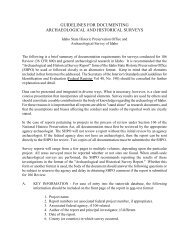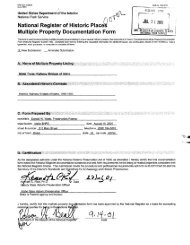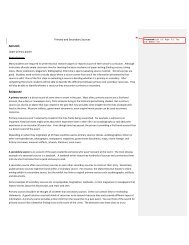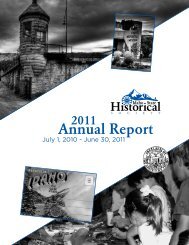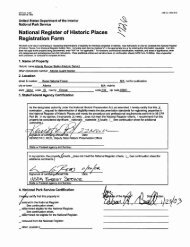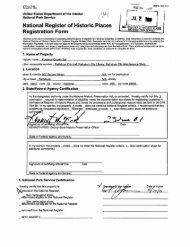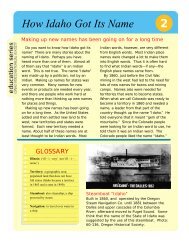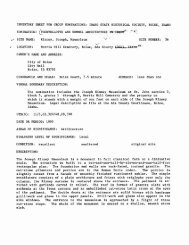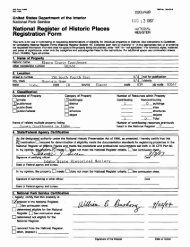Fort Hall - Idaho State Historical Society
Fort Hall - Idaho State Historical Society
Fort Hall - Idaho State Historical Society
You also want an ePaper? Increase the reach of your titles
YUMPU automatically turns print PDFs into web optimized ePapers that Google loves.
IDAHO STATE HISTORICAL SOCIETYREFERENCE SERIESFORT HALLNumber 121 January 1968Established in 1834 as an outpost of the Snake country furtrade, <strong>Fort</strong> <strong>Hall</strong> occupied a strategic position in a key area ofnorthern Shoshoni and Bannock Indian activity. The fort survivedfor slightly more than two decades, serving as a major supplystation on the Oregon Trail after 1840 when westbound emigrantsbegan to follow fur trade routes to the West Coast. After theoriginal fort was abandoned, several subsequent posts, mostlywith the same name, functioned in the area. An Indianreservation headquarters, named for the old fort, still exists afew miles east of the original site of <strong>Fort</strong> <strong>Hall</strong>.Prior to construction of <strong>Fort</strong> <strong>Hall</strong>, the Snake country furtrade had depended largely upon efforts of organized parties oftrappers who ranged widely over the beaver streams each huntingseason. This system, introduced by Donald MacKenzie, who becameactive in the <strong>Fort</strong> <strong>Hall</strong> area in 1818, prevailed throughout theimportant years of the Snake country and the Rocky Mountain furtrade. Each summer, various bands of trappers met at arendezvous to dispose of their furs and get equipped for the nextseason. Nathaniel J. Wyeth, the founder of <strong>Fort</strong> <strong>Hall</strong>, had comewest to enter the fur trade in 1832. Noting that the profits ofthe fur trade accrued to those who supplied the trappers atrendezvous, rather than to the fur hunters themselves, Wyethcontracted to supply the 1834 rendezvous. Setting out from St.Louis, April 28, with an expedition of 70 men and 250 horses, hebrought out a stock of goods large enough to take care of theRocky Mountain fur trade for a year. In addition, he planned todevelop Columbia River salmon fishing, with prospective marketsin the Hawaiian Islands and in Boston, his home base. Supportedby a Boston concern (the Columbia River Fishing and TradingCompany) capitalized to develop his fur and fishery enterprises,Wyeth expected to develop the resources of the Pacific Northweston a large scale. A base of operations on the lower Columbia,near <strong>Fort</strong> Vancouver of the Hudson's Bay Company, might eventuallyhave supplied the Rocky Mountain fur trade as well as hisColumbia River salmon fisheries.On the way to the 1834 rendezvous, held at Ham's Fork ofGreen River, Wyeth got into real trouble. Milton Sublette, withwhom he had contracted to supply the mountain men, had to turnback to St. Louis, eventually to get a leg amputated. Wyeth'sinexperienced men could not travel as fast as the regular1
2121suppliers could: before he reached his destination, the companythat had previously handled the rendezvous trade passed him onthe way to Ham's Fork and took over all the business again inutter disregard of Wyeth's contract. Because the Oregon countryextended beyond the boundaries of the United <strong>State</strong>s, civil lawdid not exist for mountain men on Ham's Fork. Wyeth doubted hecould have done anything about the breach of contract in such aplace anyway. (British subjects in the Oregon country weregoverned by the laws of Ontario, but no similar provision hadbeen made for United <strong>State</strong>s citizens west of the continentaldivide.) Anyway Wyeth had a lot of fur trade goods to dispose ofbefore he continued on to the Columbia to get his salmonfisheries in operation. His solution was to head west to SnakeRiver, where he founded <strong>Fort</strong> <strong>Hall</strong> to get rid of his surplussupplies. This unexpected change in plan also provided a basefor operations for his fur hunters in the Snake country.Wyeth reached the Snake on July 14 and chose a site for hisfort about a hundred and fifty yards from the river, at a pointseveral miles north of the Portneuf. His men went to work rightaway, erecting two houses and some horse corrals enclosed in astockade 15 feet high and 80 feet square. Complete with bastionsfor defense, his fort had a good (if possibly dangerous) locationin the center of the major Indian wintering grounds of the upperSnake valley. When the fort was near enough completed for Wyethto continue west, August 6, a dozen men, fourteen horses andmules, and three cows remained behind to occupy the only Americanoutpost then existing in the Oregon country. Two of Wyeth'strapping parties ranged out of <strong>Fort</strong> <strong>Hall</strong>, while Wyeth and theremainder of his men proceeded on to the lower Columbia todevelop his projected fisheries.Somehow nothing in the plans of the Columbia River Fishingand Trading Company really worked out, although they were wellconceived. The ship sent out from Boston to transport fish toHawaii and New England ran into a storm off South America,suffering severe damage from lightning. The Columbia salmonfisheries proved to be a failure, although a small shipment wentout. Wyeth wanted to contract with the Hudson's Bay Company toact as agent for supplying the Rocky Mountain fur trade: hisplan was to transfer the trade base from St. Louis to <strong>Fort</strong>Vancouver on the lower Columbia, from which goods could bebrought to rendezvous less expensively. John McLoughlin, whomanaged operations for the Hudson's Bay Company, was inclined togo along with Wyeth, whose plan would have delivered the northernRocky Mountain fur trade to the Hudson's Bay Company. Companypolicy did not allow for such joint ventures, however, andinstructions from London finally forbade McLoughlin to get mixedup in any such promising, though unusual, enterprise. ThomasMcKay already had established <strong>Fort</strong> Boise late in 1834 as a rivalto <strong>Fort</strong> <strong>Hall</strong> in the interest of the Hudson's Bay Company, andMcLoughlin was compelled to make <strong>Fort</strong> Boise into a company post
3121and to compete vigorously with <strong>Fort</strong> <strong>Hall</strong>.As Wyeth was aware, his only chance to succeed with <strong>Fort</strong><strong>Hall</strong> depended upon supply from the lower Columbia: when he couldnot work that out independently, and could not manage to trade incooperation with the Hudson's Bay Company, which already wasoperating from a base on the lower Columbia, he had noalternative but to clear out. In May 1836, he decided to sell<strong>Fort</strong> <strong>Hall</strong> to the Hudson's Bay Company and left negotiations ofthe transaction to a deputy. Another year or more went by whilethe deal was being worked out. Most of the traps, equipment, andhorses were sold to mountain men during the 1837 rendezvous,since the Hudson's Bay Company could bring supplies to the Snakecountry from <strong>Fort</strong> Vancouver with less expense than Wyeth hadbrought them in from St. Louis. Wyeth's plan to obtain controlof the Rocky Mountain fur trade by supplying <strong>Fort</strong> <strong>Hall</strong> from <strong>Fort</strong>Vancouver worked out just as he anticipated it would. But bythen, <strong>Fort</strong> <strong>Hall</strong> belonged to the Hudson's Bay Company.Assuming charge of the post, June 16, 1838, Hudson's BayCompany officials found a better source for furs. Rather than todepend upon parties of mountain men, they decided to employ thelocal Indians if they could persuade them to engage in furhunting. James Douglas, visiting the new British fort, reportedMarch 11, 1838, that the Shoshoni and Bannock "bravely maintainedtheir independence, and now occupy a respectable position" amongthe Indians of the Northwest. Though they were "an exceedinglyerractick people we have hopes of introducing among them moresubtle habits of life and leading them to devote more of theirtime to Fur hunting; an object worthy of our attention, as we arelikely to derive from their exertions, more certain and extensivebenefit, than we have reason to anticipate from the lawless andturbulent free white Trappers, now employed as beaver hunters. .." Not depending entirely upon the Indians, the firm still sentout expeditions of company servants and free trappers to work thesurrounding country. With the decline of the annual summerrendezvous of mountain men supplied from St. Louis, <strong>Fort</strong> <strong>Hall</strong>also served as a base for those who continued to trap the upperSnake country. T. J. Farnham noted in 1839 that "the Americantrappers even are fast leaving the service of their countrymen,for the larger profits and better treatment of Britishemployment." Goods could be purchased at <strong>Fort</strong> <strong>Hall</strong> for half theprice charged at American posts supplied from St. Louis; furscould be sold there for more than they would bring elsewhere.White trappers, who had access to other markets, got more fortheir furs than the Indians received, and paid less for theirsupplies.Attempts to make <strong>Fort</strong> <strong>Hall</strong> more self-sufficient--commencedin Wyeth's time with efforts at raising onions, peas, corn, andturnips--continued under the British company. A plow was broughtin 1839, but dry weather ruined the projected wheat corp.Cattle, traded after 1842 from emigrants on the Oregon Trail,
4121thrived around <strong>Fort</strong> <strong>Hall</strong>, though. Moreover, the fur trade itselfprospered at <strong>Fort</strong> <strong>Hall</strong> after it had declined in the Rockiesgenerally; during the winter of 1842-1843, <strong>Fort</strong> <strong>Hall</strong> and <strong>Fort</strong>Boise were responsible for 2,500 beaver, which helped that season"to make up for losses elsewhere." In 1845-1846, the Snakecountry fur trade (1,600 beaver) still was valued at L3,000.Much of the <strong>Fort</strong> <strong>Hall</strong> trade depended upon emigrant traffic by1842, however.Wagon trains could reach <strong>Fort</strong> <strong>Hall</strong> from the Missouri valleywith no particular difficulty. Taking wagons farther west provedto be more of a problem. Henry Harmon Spalding and MarcusWhitman had brought a wagon past <strong>Fort</strong> <strong>Hall</strong> in 1846, but itreached <strong>Fort</strong> Boise only as a cart. There they had to abandon italtogether. Hudson's Bay traders had managed to haul Spalding'swagon over the Blue Mountains to <strong>Fort</strong> Walla Walla in 1840. Butthey had such a hard time that they concluded that the pack trailfrom <strong>Fort</strong> <strong>Hall</strong> to the Columbia simply wasn't practical forwagons. Small emigrant pack trains made their way from theMississippi Valley via <strong>Fort</strong> <strong>Hall</strong> to the Columbia in 1839-1840 andin 1841. Then in 1842, a larger group of 137 emigrants showed upwith wagons. On the suggestion of Richard Grant, Hudson's BayCompany chief trader in charge of <strong>Fort</strong> <strong>Hall</strong>, they left the wagonsat his post, and packed the rest of the way. Grant was able tosell them flour for the rest of their journey at half the pricethey had to pay at <strong>Fort</strong> Laramie; he traded for the abandonedwagons as an accommodation to the travelers. The emigrant supplytrade increased enormously the next year with close to a thousandpeople coming through. By that time, Grant's problem, in face ofdesperate demand, was to keep back enough provisions to get <strong>Fort</strong><strong>Hall</strong> through the winter. Unable to continue westward from <strong>Fort</strong><strong>Hall</strong> without wagons, the emigrants accepted Marcus Whitman'sadvice to force their way through. They succeeded in gettingtheir wagons clear to the Columbia. Each year after that broughtanother wave of emigrants on their way to Willamette Valley. In1846, partly in response to continued emigrant traffic, the Snakecountry became part of the United <strong>State</strong>s. Pending a settlementof Hudson's Bay Company claims for posts in that part of Oregonassigned to the United <strong>State</strong>s, though, <strong>Fort</strong> <strong>Hall</strong> continued tofunction as a British post.Practically a complete shift from fur trade to emigranttrade followed not long after the boundary settlement. ExtensiveMormon migration in 1847 to Salt Lake gave <strong>Fort</strong> <strong>Hall</strong> anunexpected new market for several years, until the Mormonsettlements became self-sufficient. A dip in emigrant wagonsfrom 901 in 1847 to only 318 in 1848 came just before the end ofthe fur trade. Then the California gold rush improved thesituation abruptly. Even though much of the 1849 traffic wasdiverted southward over Hudspeth's Cutoff, Richard Grantestimated that 10,000 wagons rolled past <strong>Fort</strong> <strong>Hall</strong> that summer.At the same time, a force of mounted riflemen established a
121short-term United <strong>State</strong>s military post--Cantonment Loring--onlyabout six miles from <strong>Fort</strong> <strong>Hall</strong> in August. None of this activityencouraged the fur traders.Declining beaver prices, combined with emigrant traffic onthe Oregon and California trails, brought <strong>Fort</strong> <strong>Hall</strong> fur trade toa sudden halt in 1849. The beaver market in London had collapsedto the point that the <strong>Fort</strong> <strong>Hall</strong> rates (one Hudson's Bay Companyblanket for four beaver) had become entirely too high, and thefur trade there turned out to be "more than unprofitable." Boththe Indians and mountain men based at <strong>Fort</strong> <strong>Hall</strong> now could besupplied through trade with passing emigrants. Richard Grantreported February 22, 1850, that "the Indians have becomeCareless, and still more indolent than they ever were in huntingfurs--some of the Old Ones no doubt might be enticed to huntBeaver but that once valuable Animal having now [become]valueless, they are not encouraged. . ." The Indians, in fact,now had to hunt large animals for subsistence as well as for theemigrant trade. From 1849 on, <strong>Fort</strong> <strong>Hall</strong> had little functionexcept as a supply post for wagon trains bound for Oregon. WithHudspeth's Cutoff (1849) diverting the California traffic, alongwith many of the Oregon wagons as well, to a route farther south,<strong>Fort</strong> <strong>Hall</strong> entered an abrupt decline.Even though great Snake River floods damaged <strong>Fort</strong> <strong>Hall</strong>severely in 1853, and much of the emigrant traffic bypassed <strong>Fort</strong><strong>Hall</strong>, the British company hoped to continue to supply travelerson the Oregon Trail. Wagons began to haul flour and trade goodsfrom the Lower Columbia to <strong>Fort</strong> <strong>Hall</strong> in 1853, and pack trainswere discontinued altogether on the supply route in 1854. Indiantrouble along the Oregon Trail broke out near <strong>Fort</strong> Boise in 1854,however, and by 1856 the situation deteriorated so terribly that<strong>Fort</strong> <strong>Hall</strong> had to be withdrawn. A decade later, a generalsettlement of Hudson's Bay Company claims for the value of postsin the United <strong>State</strong>s was arranged. British interests at <strong>Fort</strong><strong>Hall</strong> thus came to an end just at the time that establishment ofan Indian reservation led to the development of a new anddifferent kind of <strong>Fort</strong> <strong>Hall</strong>. By that time, <strong>Fort</strong> <strong>Hall</strong> also hadbecome a station for stage lines hauling passengers to the newgold fields. Travelers still came by, but they no longer had tofind their way through the great uninhabited wilderness that hadfaced earlier emigrants on the Oregon and California trails.Publications--450 N. 4th Street, Boise, ID 83702--208-334-34285




